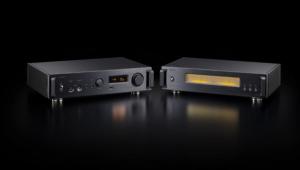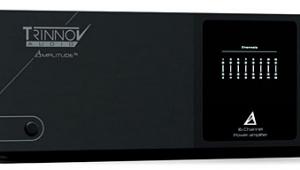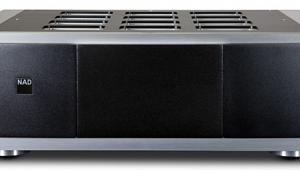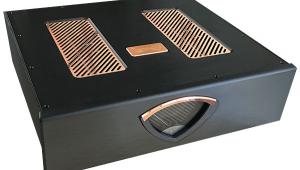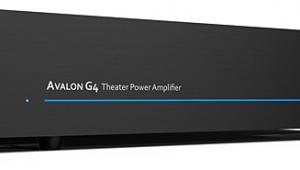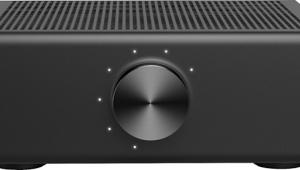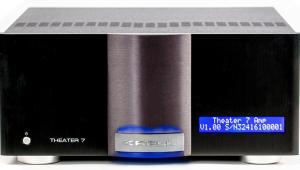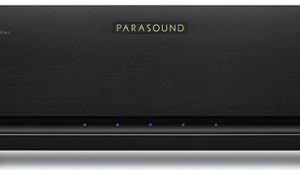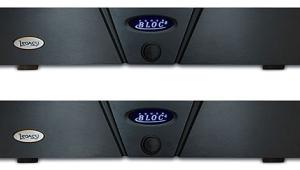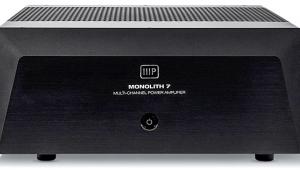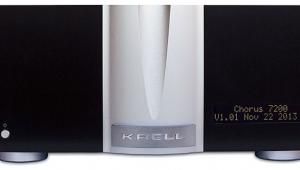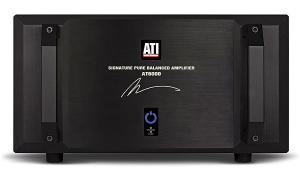Primare SP31.7 & A30.5 Mk.II surround preamplifier-processor & 5-channel amplifier A New Reference System
From the time I began doing reviews for SGHT, I knew that the video-display part of my review system—an aging 52-inch Mitsubishi front projector, the kind with the mirror that swings out—was not up to the job. Over the years since then, manufacturers have been kind enough to lend me projectors (DLP and LCD) and plasma displays for various periods while I considered my options, but the technology was changing at a rate that made it difficult for me to feel comfortable buying any projector or other video display. I was quite taken with plasmas, but my experience with projectors made me dissatisfied with the smaller size of the plasma images.
A major turning point for me was the introduction of DLP projectors based on Texas Instruments' HD1 chip. A few weeks' trial with a Sharp XV-Z9000 made me think that the technology was just about at the point where I was prepared to go for it. Then word came that TI's new HD2 chip and improved color wheel were on the way. I decided to wait a little longer.
At the 2003 Consumer Electronics Show, I spent quite a bit of time comparing the images from projectors based on the HD2 chip, as well as those from LCoS and high-end LCD projectors. My conclusion was that the Marantz VP-12S2 (whose predecessor, the VP-12S1, had impressed me at the previous year's CES) had the best overall picture quality of any of these projectors. Apart from its gorgeous picture, it seemed very well built and had the features I wanted, including an optional long-throw lens that would allow me to mount the projector in a convenient location in the back of the room. I decided to buy one. For a screen to match the VP-12S2, the obvious choice was the Stewart FireHawk—the screen that Marantz had used in the CES demo. The one I got is a 16:9 retractable unit that measures 100 inches diagonally; I mounted the Marantz projector on the ceiling, several feet behind the viewing-listening area.
Right out of the box, with only minimal tweaking of the settings, the image—DVD via component video and HDTV via RGB—was stunning, and the picture improved further with use of the DVI connection from the Marantz DV-8400 DVD player (see the November 2003 issue for a detailed "Take Two" follow-up on the VP-12S2). I no longer had to be embarrassed when my SGHT writer colleagues would ask, "What are you using for a display?"
More changes were on the way. With the screen taking up most of the front wall, there was just enough room for the front left and right speakers—but the center speaker had to be moved below the screen, and there was no longer room in front for an equipment rack. Placing the center speaker below the screen worked out very well; I was able to position it vertically, aiming it up slightly toward the listening area, which produced a more tightly focused center image than when I had the speaker oriented horizontally, near the ceiling. (All five speakers in the system are Dunlavy SC-Is.)
Finding a place for the equipment rack was tricky. A process of elimination made it apparent that the only reasonable place was behind the listening area, against a side wall. The new location of the equipment rack meant that my speaker cables were no longer the right length, and the ones I'd been using were not specified for in-wall use, which the new amplifier-speaker connections would require. At this point, I decided that it would be best to replace my assortment of cables from various manufacturers with cables from a single maker. I decided to use products from Transparent Cable: Wall Plus (speaker), MusicLink Plus (interconnects), Transparent Premium 75ohms (digital), and Premium Transparent (video).
Transparent Cable has been recognized as being in the forefront of cable technology—they've won numerous awards—and they are one of the few manufacturers of high-quality speaker cables that are CL-rated (i.e., fire-retardant) for in-wall use. Their cables feature impedance-matching networks designed to reject noise. Indeed, the first thing I noticed about the sound of the system after installing the new cables was how quiet the background was.
The new location of the equipment, behind the listening area, means that I now have to aim remote controls back over my shoulder—not convenient, but it has the advantage that bright equipment LEDs do not distract while I watch movies.
The new location of the equipment also required that I reposition the subwoofer. It had previously lived in the front left corner, but with the surround preamp-processor now behind the listening area, I would have had to run an interconnect longer than 70 feet to reach the sub, and that just didn't seem reasonable. Instead, I placed the sub in the rear corner, a location that subwoofer designer Poh Ser Hsu (of Hsu Research) had previously suggested as being more optimal in my room. This worked out very well; the low bass was strong and extended, with no audible indication that these sounds were coming from behind me. While I was at it, I got rid of the old IKEA rack I'd been using, replacing it with a stylish and extremely sturdy Synergy rack from Salamander Designs.
The installation of projector, screen, and cables was all done in a no-fuss, no-mess manner by a local home-theater dealer, Audio Excellence of Richmond Hill, Ontario. They even assembled the equipment rack. Thanks, guys!—RD
- Log in or register to post comments
